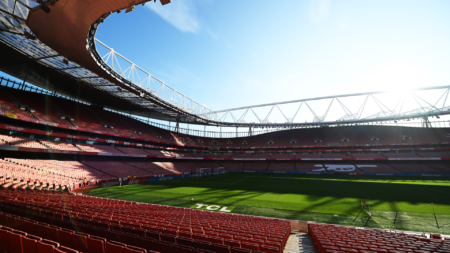Real Madrid’s Vision for the 2030 FIFA World Cup Final
Real Madrid, one of the most storied and successful football clubs in the world, is setting its sights on an ambitious goal: hosting the final of the 2030 FIFA World Cup. The club has already invested an astounding £1.5 billion in a comprehensive redevelopment of the Santiago Bernabeu, their iconic home stadium. This extensive renovation, which began in 2019 and concluded in late 2024, has transformed the Bernabeu into a modern marvel with a retractable roof, a 360-degree LED scoreboard, and a striking new metal facade adorned with 7,500 stainless steel slats. Despite these impressive upgrades, the club initially opted to avoid any significant stand expansions to maintain the stadium’s aesthetic and functional integrity during the five-year project. However, FIFA’s announcement in December that Spain, Portugal, and Morocco will co-host the 2030 World Cup has spurred Real Madrid to consider a further expansion to accommodate the grand event.
Return to the Bernabeu and Initial Capacities
The return to the Bernabeu after the lengthy construction period was a momentous occasion for Real Madrid and its fans. The stadium’s reopening in late 2024 marked the culmination of years of planning and work, and the new facilities have been widely praised. However, there is some uncertainty surrounding the exact capacity of the revamped stadium. So far this season, Madrid’s attendance has only surpassed 78,000 on two occasions, during matches against their fierce rivals Barcelona and Atletico Madrid. The current capacity of the Bernabeu is estimated to be around 79,000, which is just shy of the 80,000 minimum required by FIFA for a World Cup final venue. This discrepancy has prompted the club to explore options for expanding the stadium to meet the necessary criteria.
FIFA Requirements and Real Madrid’s Plans
FIFA’s stringent requirements for hosting the World Cup final stipulate that the stadium must have a capacity of at least 80,000. According to Spanish outlet Mundo Deportivo, Real Madrid is now eyeing a significant expansion that would increase the Bernabeu’s capacity from around 79,000 to 85,000 seats. The club is reportedly leaning towards a permanent solution rather than temporary seating, as they aim to capitalize on the investment long after the World Cup has concluded. This decision underscores Real Madrid’s commitment to not only meeting the immediate needs of the tournament but also enhancing the fan experience and potential revenue streams for the future. The ambitious expansion project would further solidify the Bernabeu’s status as one of the world’s premier football venues.
Competition from Other Venues
While Real Madrid is eager to host the 2030 FIFA World Cup final, they face stiff competition from other prestigious venues. The Barcelona FC’s revamped Spotify Camp Nou, which is undergoing a major revamp, is another top contender. Once the project is completed, the Nou Camp is expected to have a capacity of 105,000, making it a formidable rival to the Bernabeu. Barcelona are optimistic about finishing the renovations and returning to their home ground before the end of the season, though the stadium will operate at a reduced capacity while work continues. The Grand Stade Hassan II in Casablanca, Morocco, is also in the running and is set to be the largest football stadium in the world with a capacity of 115,000. This unprecedented collaboration between Spain, Portugal, and Morocco for the 2030 World Cup opens a unique opportunity for a venue in any of these countries to host the tournament’s pinnacle event.
The Unique Challenge of a Multi-Country Tournament
The 2030 FIFA World Cup will be the first time in history that three countries across two continents will officially stage the tournament. This unprecedented collaboration presents both opportunities and challenges. The co-hosting arrangement allows for a more diverse and inclusive tournament, with matches spread across a wider geographical area. However, it also means that there will be intense competition among the venues to secure the most prestigious matches, including the final. Real Madrid’s decision to invest further in the Bernabeu is a strategic move to ensure that the stadium stands out in this highly competitive landscape. The club’s history and global appeal, combined with the state-of-the-art facilities, make the Bernabeu a strong candidate for the honor.
Long-Term Benefits and Fan Experience
The proposed expansion of the Bernabeu to 85,000 seats is not just about meeting FIFA’s requirements; it’s a forward-thinking strategy that considers the long-term benefits for the club and its fans. A larger stadium means more capacity for supporters, which can lead to increased matchday revenue and a more vibrant atmosphere. The additional seating could also attract more high-profile events and matches, further enhancing the Bernabeu’s reputation as a world-class venue. Real Madrid’s commitment to a permanent solution demonstrates their dedication to providing the best possible experience for their fans and ensuring that the stadium remains a cornerstone of the club’s identity and success. As the club continues to push the boundaries of innovation and excellence, the expansion of the Bernabeu is a natural next step in their ongoing journey to become the preeminent football institution of the 21st century.











